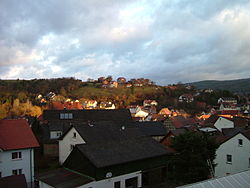Burgsinn
| Burgsinn | ||
|---|---|---|

View from the Mäusberg over Burgsinn
|
||
|
||
| Coordinates: 50°09′N 09°39′E / 50.150°N 9.650°ECoordinates: 50°09′N 09°39′E / 50.150°N 9.650°E | ||
| Country | Germany | |
| State | Bavaria | |
| Admin. region | Unterfranken | |
| District | Main-Spessart | |
| Municipal assoc. | Burgsinn | |
| Government | ||
| • Mayor | Robert Herold (BüLi) | |
| Area | ||
| • Total | 51.38 km2 (19.84 sq mi) | |
| Elevation | 190 m (620 ft) | |
| Population (2015-12-31) | ||
| • Total | 2,436 | |
| • Density | 47/km2 (120/sq mi) | |
| Time zone | CET/CEST (UTC+1/+2) | |
| Postal codes | 97775 | |
| Dialling codes | 09356 | |
| Vehicle registration | MSP | |
| Website | Municipal website | |
Burgsinn is a market community in the Main-Spessart district in the Regierungsbezirk of Lower Franconia (Unterfranken) in Bavaria, Germany and the seat of the Verwaltungsgemeinschaft (municipal association) of Burgsinn. It has a population of around 2,500.
Burgsinn lies in the Main-Spessart district, in the Mittelgebirge Spessart. It is located in the valley of the river Sinn from which it takes its name.
The community has only the Gemarkung (traditional rural cadastral area) of Burgsinn. The municipal territory stretches into the wooded hills east and west of the Sinn valley.
Burgsinn borders on (from the north, clockwise): Mittelsinn, the unincorporated areas Forst Aura and Omerz und Roter Berg, Wartmannsroth, Gräfendorf, Rieneck, Herrnwald (unincorporated area), Fellen and Aura im Sinngrund.
A stone hatchet found in Burgsinn, from the final days of the Neolithic Münchshöfener Kultur bears witness to the first known human presence in the municipal area.
In 812 a document from Fulda Abbey mentioned the Sinngau ("Sinn District"), or in the spelling of the time, Sinnahgeuue. From the year 1001 comes the first written proof of the community’s existence; at that time it was the village of Sinna, a Würzburg holding. In 1303 a source speaks of Burgmannen of Gotzo, Aplo et Her (mannus) de Sinne occupying the Sinna border fortifications. In 1334, Emperor Ludwig der Bayer granted dem Dorf zu Synne ("The Village at Synne") everlasting market rights. In 1338, Dietz von Thüngen became hereditary Burgmann and lord of the castle and locality of Sinna. Dietz von Thüngen's son Wilhelm acquired the Burgsinn lordship, with all appurtenances, in 1405 for 10,000 Gulden
...
Wikipedia



